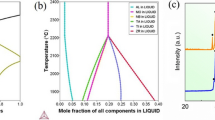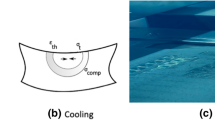Abstract
The partial strengthening method for pre-stamped panels both avoids excessive strength enhancement over the entire product and substantially reduces the processing cost compared to conventional hot press forming. In this paper, we propose two types of partial strengthening processes to selectively increase the local strength of a cold stamped B-pillar by utilizing an induction coil system and water spray quenching to induce the martensitic transformation in the target region. Thermo-mechanical FE analyses were conducted to evaluate the effect of the process parameters such as the quenching rate, quenching time, and heating width on the shape changes during the partial strengthening processes while simultaneously considering the thermal dilatation and transformation plasticity.
Similar content being viewed by others
References
Miyanish M (2010) Manufacturing of light weight cars, Steel Research International Supplement Metal Forming 81, 1-8.
Schiebl G, Possehn T, Heller T, Sikora S (2004) Manufacturing a roof frame from ultra high strength steel materials by hot stamping, IDDRG international deep drawing research group 2004 conference
Merklein M, Lechler J (2006) Investigation of the thermo-mechanical properties of hot stamping steels. J Mater Process Technol 177:452–455
Karbasian H, Tekkaya AE (2010) A review on hot stamping. J Mater Process Technol 210:2103–2118
Steinbeiss H, So HW, Michelitsch T, Hoffmann H (2007) Method for optimizing the cooling design of hot stamping tools. Prod Eng 1:149–155
Zhong-de S, Mi-lan Z, Chao J, Ying X, Wen-juan R (2010) Basic study on die cooling system of hot stamping process, Advanced technology of design and manufacture, International conference on: IET, 1-4.
Lim WS, Choi HS, Ahn SY, Kim BM (2014) Cooling channel design of hot stamping tools for uniform high-strength components in hot stamping process. Int J Adv Manuf Technol 70:1189–1203
Barnes TA, Pashby IR (2000) Joining techniques for aluminum space frames used in automobiles, Part II - adhesive bonding and mechanical fasteners. J Mater Process Technol 99:72–79
Chen CM, Kovacevic R (2004) Joining of Al 6061 alloy to AISI 1018 steel by combined effects of fusion and solid state welding. Int J Mach Tools Manuf 44:1205–1214
Moon HI, Jeon YE, Kim DY, Kim HY, Kim YS (2012) Crumple zone design for pedestrian protection using impact analysis. J Mech Sci Technol 26:2595–2601
Maikranz-Valentin M, Weidig U, Schoof U, Becker HH, Steinhoff K (2016) Components with optimized properties due to advanced thermo-mechanical process strategies in hot sheet metal forming. Steel research international 79:92–97
Merklein M, Wieland M, Lechner M, Bruschi S, Ghiotti A (2016) Hot stamping of boron steel sheets with tailored properties: a review. J Mater Process Technol 228:11–24
Hein P, Wilsius J (2008) Status and innovation trends in hot stamping of USIBOR 1500P. Steel research international 79:85–91
Lenze FJ, Banik J, Sikora S (2008) Application of hot formed parts for body in white. Proceedings of the IDDRG conference:511–519
Kerausch M, Merklein M, Geiger M, (2003) Improved material flow for deep drawing of aluminum blanks by local laser heat treatment, Proceedings of the 10th international conference on sheet metal, 73-80.
Hein P, Kefferstein R, Dahan Y (2006) Pressharten von Usibor 1500P: Simulationsbasierte Bauteil-und Prozessanalyse, In Liewald, M. (Ed.): Neuere Entwicklungen in der Blechumformung. MAT INFO Werkstoff-Informationsgesellschaft
Mori K, Maeno T, Mongkolkaji K (2013) Tailored die quenching of steel parts having strength distribution using bypass resistance heating in hot stamping. J Mater Process Technol 213:508–514
Asnafi N, Andersson R, Persson M, Liljengren M (2016). Tailored boron steel sheet component properties by selective laser heat treatment, IOP Conference Series: Materials Science and Engineering 159
Mori K, Okuda Y (2010) Tailor die quenching in hot stamping for producing ultra-high strength steel formed parts having strength distribution, CIRP Annlas - Manufacturing. Technology 59:291–294
Banik J, Lenze FJ, Sikora S, Laurenz R (2011) Tailored properties - a pivotal question for hot forming, 3rd International conference on hot sheet metal forming of high-performance steel 13-20.
Casas B, Latre D, Rodriquez N, Valls I (2008) Tailor made tool materials for the present and upcoming tooling solutions in hot sheet metal forming, 1st International conference on hot sheet metal forming of high performance steels, 23-26.
Geiger M, Merklein M, Vogt U (2009) Aluminum tailored heat treated blanks. Ann Acad Soc Product Eng 3:401–410
Vogt S, Bechheim L, Banik J, Flaischerowitz M, Weisheit A, Schleifenbaum JH (2018) Local laser softening of press-hardened steel at high feed rates. J of Laser App 30:031201
Ghiotti A, Bruschi S, Borsetto F (2011) Tribological characteristics of high strength steel sheets under hot stamping conditions. J Mater Process Technol 211:1694–1700
Nakagawa Y, Mori KI, Maeno T (2018) Spring-back-free mechanism in hot stamping of ultra-high-strength steel parts and deformation behaviour and quenchability for thin sheet. Int J Adv Manuf Technol 95:459–467
Järvenpää A, Jaskari M, Hietala M, Mäntyjärvi K (2015) Local laser heat treatments of steel sheets. Phys Procedia 78:296–304
Bok HH, Choi JW, Suh DW, Lee MG, Barlat F (2015) Stress development and shape change during press-hardening process using phase-transformation-based finite element analysis. Int J Plast 73:142–170
Greenwood GW, Johnson RH (1965) The deformation of metals under small stresses during phase transformations. Proc R Soc 283:405–422
Akerstorm P, Wikman B, Oldenburg M (2005) Material parameter estimation for boron steel from simultaneous cooling and compression experiments. Model Simul Mater Sci Eng 13:1291–1308
Garcia Aranda L, Chastel Y, Fernández Pascual J, Dal Negro T (2002) Experiments and simulation of hot stamping of quenchable steels. Adv Tech Plast 2:1135–1140
Bok HH, Kim SN, Suh DW, Barlat F, Lee MG (2015) Non-isothermal kinetics model to predict accurate phase transformation and hardness of 22MnB5 boron steel. Mater Sci Eng A 626:67–73
Lucía O, Maussion P, Dede EJ, Burdío JM (2014) Induction heating technology and its applications: past developments, current technology, and future challenges. IEEE Trans Ind Electron 61:2509–2520
© 2018 AutoForm Engineering GmbH, AutoFormPlus R7 Software, accessed Aug 17. 2018, https://www.autoform.com/kr/.
Description of material behavior, AutoFormPlus R7 software manual, last modified Nov 4. 2016, accessed Aug 17. 2018, http://www.caxopen.com/static/af/EN/04_Solver/040601_DescriptionMB/040601_DescriptionMB.htm.
Kim HY, Park JK, Lee M-G (2014) Phase transformation-based finite element modeling to predict strength and deformation of press-hardened tubular automotive part. Int J Adv Manuf Technol 70:1787–1801
Funding
This work was financially supported by the “Forming analysis of center pillar stiffener with partial strengthening techniques” program of the Production Development Division Department, HYUNDAI Motors Group, and “Human Resources Program in Energy Technology” program of the Korea Institute of Energy Technology Evaluation and Planning (KETEP) under the Ministry of Trade, Industry and Energy, Republic of Korea (no. 20174010201310).
Author information
Authors and Affiliations
Corresponding author
Additional information
Publisher’s note
Springer Nature remains neutral with regard to jurisdictional claims in published maps and institutional affiliations.
Rights and permissions
About this article
Cite this article
Kim, K., Song, Y., Yang, W. et al. Partial strengthening method for cold stamped B-pillar with minimal shape change. Int J Adv Manuf Technol 102, 4241–4255 (2019). https://doi.org/10.1007/s00170-019-03516-5
Received:
Accepted:
Published:
Issue Date:
DOI: https://doi.org/10.1007/s00170-019-03516-5




